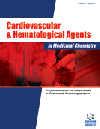- Home
- A-Z Publications
- Cardiovascular & Hematological Agents in Medicinal Chemistry (Formerly Current Medicinal Chemistry - Cardiovascular & Hematological Agents)
- Previous Issues
- Volume 10, Issue 1, 2012
Cardiovascular & Hematological Agents in Medicinal Chemistry (Formerly Current Medicinal Chemistry - Cardiovascular & Hematological Agents) - Volume 10, Issue 1, 2012
Volume 10, Issue 1, 2012
-
-
Eidtorial from Editor-in-Chief : [ Keeping up with Advances in Cardiovascular and Hematological Medicine in 2012 ]
More LessWelcome to the first issue of 2012 of Cardiovascular & Hematological Agents in Medicinal Chemistry. I hope everyone has had a wonderful holiday season and I want to wish everyone a wonderful New Year. As you are aware, our journal aims to cover the latest and outstanding developments in medicinal chemistry, rational drug design for the discovery of novel cardiovascular and hematological agents and discusses such therapi Read More
-
-
-
Editorial from Guest Editor [ Hot Topic:Current Status of Therapeutics and Preventive Measures for Patients with Thalassaemia and Sickle Cell Disease (Guest Editor: P.H. Reddy)]
More LessHemoglobin disorders, including thalassemia and sickle cell disease, are prevalent in populations that evolved in moderate and humid climates where malaria was endemic. Thalassemia is an inherited, autosomal recessive disease that involves a reduced rate of synthesis of a globin chain that is essential for hemoglobin synthesis. This reduced synthesis can cause abnormal hemoglobin molecules to form, leading to anemia Read More
-
-
-
Community Expansion and Gene Geography of Sickle Cell Trait and G6PD Deficiency, and Natural Selection against Malaria: Experience from Tribal Land of India
More LessBy R. S. BalgirMalaria is globally endemic in tropical and subtropical regions and so is the hemoglobinopathies, thalassemias and glucose-6-phosphate dehydrogenase (G6PD) deficiency. This biological dogma of hyper-endemic all over the tribal land in India leads to high morbidity and mortality. The directed genetic abnormalities of human erythrocytes have found to decrease the susceptibility towards malaria parasites and the heter Read More
-
-
-
Experience with Multiplex ARMS (MARMS)-PCR for the Detection of Common βThalassemia Mutations in India
More LessBeta (β) Thalassemia is a common globin gene disorder in India. Although about 65 different mutations are known in the multiethnic populations of India, the group of 9 ‘core mutations’, i.e. IVSI,5 (G>C){HBB:c.92+5G>C}, 619 base pair deletion(bp del){NG_000007.3:g.71609_72227del619}, FS8/9 (+G){HBB:c.27_28insG}, IVSI,1 (G>T) {HBB:c.92G>T}, FS41/42 (-CTTT){HBB:c.124_127del-CTTT}, C15 (G>A){HBB:c.47G>A}, FS Read More
-
-
-
Cardiovascular Aspect of Beta-Thalassaemia
More LessAuthors: Amar Taksande, Shakuntala Prabhu and Sumitra VenkateshBeta-Thalassaemia Major is a genetic blood disorder caused by the reduced synthesis of beta globin chain. The consequences of the resulting chronic anaemia are also common and include growth retardation, bone marrow expansion, extramedular hematopoiesis, splenomegaly, increased intestinal iron absorption, susceptibility to infections, and hypercoagulability. Transfusional iron overload can affect heart funct Read More
-
-
-
30 Years Lost in Anesthesia Theory
More LessThe recent discovery of the “Stress Repair Mechanism” (SRM) enables the Unified Theory of Medicine postulated by Hans Selye. It confers cohesive theories of anesthesia, analgesia, and allostasis that enable the alteration of anesthetic technique to optimize surgical outcome. The SRM continuously maintains and repairs the vertebrate body in accord with stressful forces and stimuli. Three synergistic pathways activate t Read More
-
-
-
What is the Evidence for the use of Adrenaline in the Treatment of Neonatal Hypotension?
More LessAuthors: Liam Mahoney, David Crook, Kerstin N. Walter, Ella Sherman and Heike RabeAim: The authors of this review present the current evidence of the physiology, indications and use of adrenaline in neonates, with particular focus on the treatment of hypotension. Method: A structured literature search was performed across selected electronic databases, reference lists and related articles. Abstracts arising from the search were screened for relevance according to predefined inclusion criteria. Full articles for Read More
-
Volumes & issues
-
Volume 23 (2025)
-
Volume 22 (2024)
-
Volume 21 (2023)
-
Volume 20 (2022)
-
Volume 19 (2021)
-
Volume 18 (2020)
-
Volume 2 (2020)
-
Volume 17 (2019)
-
Volume 16 (2018)
-
Volume 15 (2017)
-
Volume 14 (2016)
-
Volume 13 (2015)
-
Volume 12 (2014)
-
Volume 11 (2013)
-
Volume 10 (2012)
-
Volume 9 (2011)
-
Volume 8 (2010)
-
Volume 7 (2009)
-
Volume 6 (2008)
-
Volume 5 (2007)
-
Volume 4 (2006)
Most Read This Month
Article
content/journals/chamc
Journal
10
5
false
en


